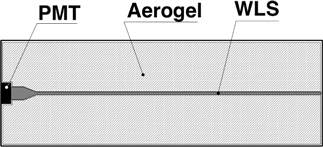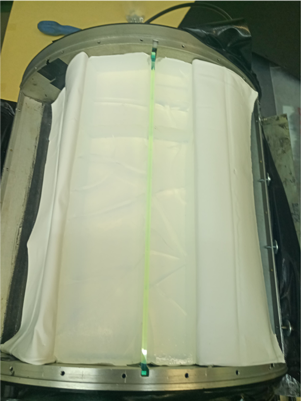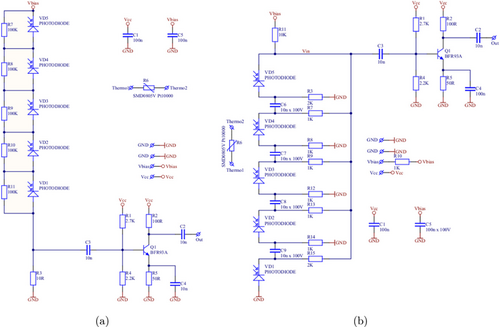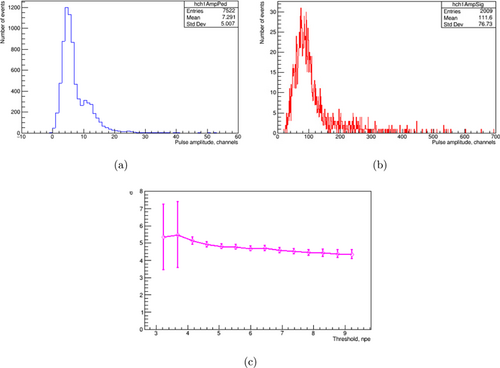Status and R & D of ASHIPH-SiPM option for PID
Abstract
The ASHIPH (Aerogel, SHifter, PHotomultiplier) Cherenkov counters are considered as a particle identification system alternative option for the detector on future Super Charm-Tau factory. The ASHIPH counters have been operating successfully in the KEDR and SND experiments in Novosibirsk at the Budker Institute of Nuclear Physics. Previously in our experiments Micro Channel Plate PMTs were used for the photon detection in the ASHIPH counters. Now, we have developed a prototype of the ASHIPH counter with SiPM (Silicon PMTs) array as a photodetector. Such an upgrade will increase the number of detected photoelectrons by 2.5 times and consequently improve the quality of particle separation. The results of testing the ASHIPH counter prototype on the electron test beam facility of the VEPP-4M accelerator is presented.
1. Introduction
ASHIPH method of light collection for particle identification (PID) was suggested at the Budker Institute of Nuclear Physics (BINP, Novosibirsk) in 1992.1 Cherenkov light from a particle in aerogel is collected by the wavelength shifter (WLS) placed in the middle of the counter. Re-emitted Cherenkov light is guided by WLS to a photomultiplier (PMT). Schematically, the ASHIPH counter is shown in Fig. 1. The usage of WLS allows us to reduce the total number of PMT in the system and increase size of the counter.

Fig. 1. Scheme the ASHIPH counter.
The PID systems of aerogel threshold Cherenkov counters based on ASHIPH technique are used successfully in the KEDR and SND detectors for experiments at VEPP-4M and VEPP-2000 e+e−-colliders, respectively, at BINP.
The ASHIPH system for the KEDR detector consists of 160 counters arranged in two layers (see Refs. 2 and 3 for more details). The volume of aerogel is 1000 liters, and its refractive index is 1.05. For the photon detection we use the Micro Channel Plate (MCP) PMTs with multialkali photocathodes of 18 mm diameter capable of working in the magnetic field up to 4.5T.4 The system provides π/K separation in the momentum range from 0.6 to 1.5GeV/c better than 3.5σ. At the beginning of the experiment we had more than 10 photoelectrons for relativistic particle, passing the counter perpendicularly, when we sum the amplitudes in both layers.
The ASHIPH system for the SND detector consists of nine counters arranged in one layer with the thickness of 30mm.5 The volume of aerogel is 7L, its refractive index is 1.13. For the photon detection the same MCP PMTs are used as in the KEDR detector. The system is intended for π/K-separation from 0.3 up to 0.9GeV/c momentum.
Replacing MCP PMT with a modern SiPM can allow us to increase the number of photoelectrons and π/K-separation of the ASHIPH counters.
2. ASHIPH Method Upgrade: SiPM as Photon Detector
For MCP, MPT manufactured by “Ekran FEP” (Novosibirsk) photon detection efficiency (PDE) is max at about 14%, which is determined by maximum quantum efficiency of 23% at λ=500nm for multialkali (Sb–Na–K–Cs) photocathode and by photoelectron collection coefficient of ∼0.6. MCP PMTs work in axial magnetic field4 and have high operating voltage 2÷4kV.
Today SiPMs seem to be the most attractive option for a photon detector in the ASHIPH systems. SiPMs might be employed for the light detection as they are quite compact, have low operating voltage <100V and are immune to the magnetic field. SiPM in comparison with MCP PMT has a higher PDE up to 40÷50%, therefore, we can expect that the number of photoelectrons detected for a relativistic particle will be increased by 2÷2.5 times giving a total 20 for an SND ASHIPH counter.
SiPM with a larger unit area, such as the Hamamatsu S14160 or NDL EQR20 series, is preferred for ASHIPH. These SiPMs can also be combined into arrays to increase the photosensitive area. MPPC S13363-3050NE-16 is a linear 16-channel SiPM array manufactured by Hamamatsu, which has effective photosensitive area of 3×3mm per channel, 3584 micropixels per channel and PDE=40% at λ=500nm.6
The disadvantage of SiPMs is the high dark count rate (DCR) of ∼55kHz/mm2 per channel at the room temperature. For an ASHIPH counter with SiPM the underthreshold efficiency will be mainly determined by its own DCRs. By setting a threshold proportional to the particle momentum, we can achieve reliable π/K-separation and significantly reduce the impact of SiPM dark counting.
3. ASHIPH-SiPM Proposal for the Super Charm-Tau Factory (Sarov)
3.1. ASHIPH system
The ASHIPH method with SiPM could be considered as an option of the PID system for the SCTF (Sarov, Russia). The main parameters of the proposed ASHIPH system for the SCTF project are as follows7:
3-layer system design: one layer with n1=1.03 (2000 L) and two other layers with n2=1.015 (4000L);
the counter dimensions are 18×30×8cm3;
WLS dimensions are 0.3×28×6cm3;
a counter is readout by one SiPM array of 20 pixels each with 3×3mm2 size or 60×3mm2 SiPM area in total;
material budget for the normal incidence is 14%X0;
number of counters in the system is 1400;
SiPMs are cooled to −40∘C to minimize DCR and radiation damage effects.
About 20 Cherenkov photons could be detected in the proposed system for relativistic particles in each subsystem: one with n1=1.030 (8cm thick) and the other with n2=1.015 (16cm thick). In Fig. 2, the dependencies of the number of detected photons in the ASHIPH system on momentum for different particles are presented. The dependencies are obtained with help of parametric simulation. According to calculation and parametric simulation such PID system is able to provide good π/K-separation from 0.5 up to 2GeV/c and μ/π-separation from 0.4 up to 0.9GeV/c.7

Fig. 2. Dependencies of the detected number of photoelectrons in the ASHIPH system on momentum for different particles. The signals for the ASHIPH system based on aerogel with n=1.030 are presented on left plot and for ASHIPH system based on aerogel with n=1.015 — on right plot.
3.2. On physics background pile-up in the ASHIPH system
From preliminary estimations based on simulation in the FLUKA framework the physics background at the SCTF e−e+-collider in general consists of two components: BhaBha scattering events and two-gammas electron–positron pairs production events.8 The main impact from these events comes not from interaction point but from numerous secondary particles produced in materials of inner and outer detector systems. The most part of secondary charged particles consists of electrons and positrons which are able to generate Cherenkov light in aerogel. This affects the performance of Cherenkov threshold detectors by giving additional Cherenkov photons in the counter when primary particles from IP are under threshold and do not produce Cherenkov light itself. It leads to misidentification due to background pile-up in the Cherenkov counters.
Therefore, it is very important to estimate quantitatively the pile-up effects. In ASHIPH counter time resolution (σt) is determined by decay time of the wavelength shifter dye (BBQ) which is equal to 15ns (see Ref. 2). It means that time gate for DAQ should be about 75ns (5⋅τ, where τ is WLS decay time). For instance, the design of SCTF distance between two neighbours bunches is 6ns.9 So, the highest operation rate (OR) of the counter is about OR=1/75ns=13MHz. While the rate (R [tracks per second in the counter]) of background charged particle tracks in the ASHIPH counter could be calculated from estimated distribution intensity of track per cm2 (ftr) from FLUKA simulation as following: R=ftr⋅S(cnt). The probability (Prob) of physics and beam correlated background pile-up in the ASHIPH counters as well as fraction of affected events could be estimated as follows :
There are two possibilities to decrease probability of background pile-up in the ASHIPH counters:
Decrease the area of the counter, but it leads to the increase of their the number.
Decrease of WLS decay time. For instance, modern wavelength shifters have very short decay time that can be as low as 0.7ns.11
Also it is necessary to take into account the probability to get backward EM-shower from the calorimeter which can give Cherenkov photons in ASHIPH counters coinciding with a track of under-threshold particle. EM-shower in backward direction usually consists of soft electron or positron tracks which could be strongly bended by axial magnetic field. According to simulation, some gap between PID system and calorimeter can help to reduce the influence of this effect.
4. ASHIPH-SiPM Counter Prototype
To create a prototype of an ASHIPH-SiPM counter a segment of the ASHIPH system of the SND detector was used. This makes it possible to compare the number of photoelectrons for MCP PMT and SiPM is used as photon detector. The segment consists of three separate counters in a common aluminium frame and we are using only one counter volume. The counter prototype photo is shown in Fig. 3. The segment has cylindrical shape: internal radius is 105mm, external radius is 141mm, central angle is 40∘ and lenght is 260mm. The WLS is displaced by 5∘ from the counter center. The inner surfaces of the counter walls are covered with PTFE film with reflection coefficient R ∼ 98%. The counter is filled by four aerogel tiles with n=1.12 and a thickness of 25mm (tiles sizes: 160×50×25mm3, 70×50×25mm3, 160×30×25mm3, 70×30×25mm3). The counter is not fully filled up to 30 mm thickness with aerogel.

Fig. 3. The ASHIPH-SiPM counter prototype.
Two schemes of SiPMs connection which differ by bias voltage distribution were considered (Fig. 4). A single sensor with an active area of 45mm2 is formed by combining five independent small MPPC chips (3×3mm2 each) cut from a Hamamatsu S13363-3050NE-16 array. From simulation for the series connection we have shorter pulse and higher pulse amplitudes in comparison with parallel connection. The five SiPMs are connected in series with decoupling capacitors in between such that the five SiPM are biased by a common voltage. This connection scheme is more advantageous than the simple series connection. The bias voltage is the same as the one for the single SiPM in contrast to the five times higher bias voltage required for the simple series connection. In both schemes the same preamplifier with single transistor stage is used. The typical waveforms from both schemes for the signal with two photoelectrons from the five SiPMs connected in series are shown in Fig. 5.

Fig. 4. Scheme of the series connection of the 5-channel SiPM array with (a) simple bias voltage divider; (b) parallel bias voltage distribution.

Fig. 5. Typical waveforms of the two-photoelectron signal for different bias voltage distributions: simple bias voltage divider (left) and parallel bias voltage distribution (right).
5. Tests with ASHIPH-SiPM Counter Prototype on Test Beam Facility
5.1. Scheme of the experiment
The tests with ASHIPH-SiPM counter prototype were performed with the electron test beam facility of VEPP-4M e+e−-collider at the BINP.12 In our experiments, the electrons with 2.5GeV energy were used. The scheme of the experiment is shown in Fig. 6. Particle tracking was performed by three coordinate gas electron multipliers (GEM)-based detectors with intrinsic resolutions σx,y∼40μm installed at about 1m distance between each other. As a trigger for the data acquisition system the coincidence of the signals from MCP-TRG1 and MCP-TRG2 located in front the ASHIPH counter was used. MCP-TRG counters are based on photomultiplier tube with micro-channel plates (MCP-PMT) with Cherenkov radiator (plexiglas round tablet optically coupled to the photocathode). For the readout of the signals a 12-bit 5GSample/s waveform digitizer (CAEN-V1742) was used. For each geometrical area and each bias, voltages on the SIPMs 50k events were collected. The room temperature during data acquisition was 25∘C.

Fig. 6. The scheme of the experiment with ASHIPH-SiPM counter.
5.2. Test beam results
Measurement of the number of photoelectrons (Nph.e.) from relativistic particles and inhomogeneity of the light collection investigation in the counter on test beam were performed. Figure 7 shows the maps with the resulting Nph.e. at various geometric points and different bias voltages on the SIPMs. To determine Nph.e. two methods were employed: search of the maximum pulse amplitude on waveforms and integration of the pulse on waveforms. The difference between results from these two methods is not more than 1ph.e. The number of photoelectrons was calculated as Nph.e.=(Asig−Aped)/A1ph.e., where Asig is the mean amplitude of the signal spectrum (see Fig. 8), Aped — electronics pedestal position, and A1ph.e. is the mean amplitude of the single-photoelectron spectrum. A1ph.e. is determined by LED pulsed calibration.

Fig. 7. Maps with the resulting Nph.e. at various geometric points and different bias voltages on the SIPMs.
The maximum number of photoelectrons in the counter is 16.3 in the closest to SiPM geometrical point and the inhomogeneity of the light collection is ∼40% over the counter, which is the difference between the maximum and minimum values of Nph.e.. The underthreshold efficiency is mainly determined by its own DCR. We can estimate the expected separation power in terms of σ as

Fig. 8. (a) Noise spectrum — spectrum collected in time window before the signal; (b) Signal spectrum; (c) Separation power from threshold in number of photoelectrons.
6. Summary
We have developed the ASHIPH counter prototype with SiPMs as photon detector. Tests with ASHIPH-SiPM counter prototype on the beam test facility at BINP were performed. We have received the following results: average amplitude is around 14ph.e.; inhomogeneity of the light collection is ∼40% over the counter; estimated separation power is better than 4σ at the threshold of 4.5ph.e. at T=25∘C.
The number of photoelectrons can be compared for SiPM and MCP PMT since we have used the same counter vessel as in the ASHIPH system of the SND detector where the MCP PMT is used. We need to take into account correction factor equal 1.3 related with slight difference in the refractive index of the aerogel (1.12 versus 1.13) and its thickness (25mm versus 30mm). At the start the SND experiment signal amplitude in the ASHIPH system counters was 8ph.e. in average and corrected for refractive index number of photoelectrons for ASHIPH-SiPM counter is 14⋅1.3=18.2. The ratio Nph.e.(ASHIPH-SiPM)/Nph.e.(ASHIPH-MCP PMT)≈2.2 agrees with PDE ratio for SiPM and MCP PMT.
The ASHIPH-SiPM Cherenkov counter was prototyped and successfully tested on the electron beam line.
| You currently do not have access to the full text article. |
|---|


